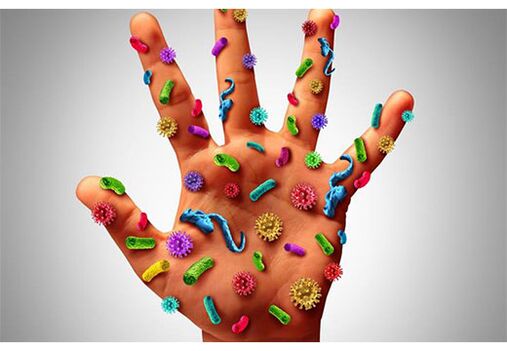Papillomavirus is one of the most common infections affecting all age groups. The danger is the combination of the manifestations of infection with the development of oncology. To prevent infection, you need to know how HPV is transmitted.

Ways of transmission of human papillomavirus
Papillomavirus is a ubiquitous infection, due to its high infectivity, the diversity of virus species, and its ability to remain harmless in the environment in exfoliated keratinized cells of the epidermis. The disease remains unmanifested in the body, a person does not suspect that he is a carrier of HPV for a long time. The virus is dangerous because some types have an oncogenic risk and are associated with cancer.
There are many different routes of infection and transmission of human papillomavirus with direct contact.
Sexual intercourse
According to research, the main way of transmission of genital HPV is sexual intercourse. Both men and women can be carriers of HPV. When infected with a virus carrier during sexual intercourse without a condom, the pathogen penetrates the basal layer of the stratified squamous epithelium and infects the cells. It can be in an episomal state, not integrated into the genome of the host cell, or integrated (integrated). HPV is inactive in the epidermis. Despite the absence of clinical symptoms, the possibility of infection with a partner remains. Microtraumas of the mucous membrane occur during sexual intercourse, which helps to release the pathogen to the surface and infect the partner.
Infectivity increases when condylomas appear. Cells contain mature viral particles that come to the surface of the mucous membrane or skin. Condylomas are dangerous, they are a source of HPV.
The formation of condylomas is characteristic of HPV 6 and 11 genotypes. It is found in 70% of cases of referral to gynecology.
Thanks to this transmission mechanism, growths have a characteristic localization in the intimate area:
- external and internal genitalia;
- anal region;
- the mucous membrane of the oral cavity.
In men, the head, foreskin and external opening of the urethra are affected. In women - external and internal labia, vagina, perineum, perianal region.
Removal of genital warts is an important stage of treatment that should not be neglected.

Household road
You can get HPV in everyday life. The place of appearance is typical for vulgar warts on the fingers, periungual ridges, outer surface of the hands, forearm, face and other parts of the body. The patient's family members (parents, children) are affected. Papillomavirus is transmitted to another person when using common hygiene tools (towels, shoes), shaking hands, wearing the same clothes, hugging.
There is a chance of infecting others when visiting crowded places. This applies to swimming pools, saunas, baths, where the risk of HPV transmission is high.
Through a kiss
Sometimes any type of HPV is transmitted by a simple kiss, affecting the mucous membrane of the mouth and the skin of the face. Types 6 and 11 most commonly affect the oral cavity. They are found in 90% of cases with genital warts. Strains 2, 16, 18, 33 can occur with varying degrees of oncogenicity.
Saliva contains infected eroded epithelium. During a kiss, part of the skin enters the other person's body. Transmission of infection occurs. Violation of the integrity of the mucous membrane leads to infection. Minor injuries caused by brushing teeth or eating hot, rough foods are not observed in the oral cavity. This violates the local protection of biological barriers.
From mother to child
If the expectant mother was infected before pregnancy, the disease may progress to the stage of advanced clinical symptoms during pregnancy due to hormonal changes. If these are vulgar warts and there is no damage to the genitals, then there is nothing to fear. It is enough to always consult a doctor. If the genitals are affected, there is a possibility that the child will be infected while passing through the birth canal. The skin, mucous membranes of the oral cavity, pharynx and upper respiratory tract are affected. The disease can recur and cause papillomatosis, affecting the vocal cords and larynx.
It cannot be transmitted to the baby through blood through milk and placenta during breastfeeding.
Are papillomas on the body contagious?
The skin of the body is affected by vulgar, flat, plantar warts. Each of them differs in appearance and structure.
Transmission occurs through contact with the affected skin. Promotes damage to the stratum corneum of the epidermis. HPV foci are located on the hands, the infection spreads quickly. The appearance of warts is caused by the type 2 virus, which has a low oncogenic risk and is considered safe. Warts are characteristic of childhood and adulthood. They usually disappear on their own within two years.
Flat papillomas are caused by types 3 and 5. Typical sites are the face and hands. It is typical for adolescence.
Plantar warts are caused by type 1. It appears in places of constant friction and pressure of shoes. It is transmitted by household contact using common footwear, foot towels, and swimming pools.
Normally, due to local immunity, the body does not get infected with this type of warts on first contact. However, it can be transmitted after a cold or flu.
Genital HPV is acquired during the first sexual intercourse in 60% of cases. If a woman is infected, she can transmit the virus to 9 out of 10 of her partners. Due to the high infectivity of condylomas, close contact and the appearance of microtraumas.

Can only one partner have HPV?
Only one partner can have HPV, but it is impossible to be 100% sure. Often people do not suspect that they are infected due to the long incubation period, neglect contraception and infect their partners.
Effective resistance to HPV is possible when the immune system of one of the partners is strong.
If the infection occurs in a hidden situation, a person does not suspect that he is sick. In this case, the virus is transmitted to the partner.
Is it possible to prevent infection?
Infection can be prevented by affecting the triggering factors that contribute to the transmission of the disease. You must follow the rules:
- rarely changes sexual partners;
- observe the rules of personal hygiene;
- Do not use only slippers, linen, towels.
An effective way is vaccination. Performed from 9 to 26 years of age without HPV. Vaccination is carried out at an older age, if there is no transmission of the virus. For this, a diagnostic method is used to determine the presence of papillomavirus DNA. There are two vaccines. They allow you to develop specific immunity and prevent infection with the most common, dangerous strains - 6, 11, 16 and 18. One of the vaccines is used to vaccinate boys, the use of the second vaccine in men does not give any results.
Currently, only a few countries have added vaccines to the mandatory list (USA, UK).
Vaccines provide immunity for up to 5 years. Transfer is not possible during these years.
Prevention of complications
There are several stages to prevent the development of cancer in women:
- primary prevention;
- secondary;
- higher
Primary prevention methods include vaccination.
Secondary prevention includes examinations by medical specialists (dermatologist, gynecologist) to determine the pre-cancerous condition (cervical erosion, dysplasia, polyps) and timely treatment.
Tertiary treatment includes a number of therapeutic measures for the treatment of subclinical, clinical forms of HPV, including drug therapy and surgical removal of growths.
Currently, vaccination is considered the most effective way to prevent the transmission of infection.


















